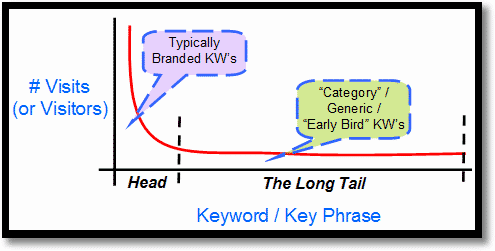
The CEO enters, shakes my hand, offers me a seat and gets right to the point. “Let’s cut straight to the chase: Can you help us get on the first page of Google?” inquires the CEO, who’s leaning forward, elbows on the table, eyes glaring into mine.
“That’s the question we need you to answer for us. Because that’s the only way we’re going to spend money with you.”
I begin with, “That’s a loaded answer, for—.”
“Stop talking,” he says. “Can you get us to the first page of Google? Can you?”
I do the only thing I can: I lie.
“Yes. I can get you to the first page of Google. I guarantee it.”
Hearing those words, the CEO leans back, glancing at his CMO and CFO, who’s now entered the room, then says “Well…? Keep talking.”
“By using the millions of dollars you’re going to give me for PPC ads,” I said
We all had a big laugh (me, nervously), which providing me with the occassion to talk about content, which was their real opportunity.
Being No.1 On Google Shouldn’t Be Your First Priority
I made them aware of a few facts that should be used to guide their steps, but they are just as useful for your business as well:
- Being No. l on Google doesn’t guarantee success (e.g., they could burn money in PPC with little to show for their efforts)
- Conversions will matter, but they matter a lot less when you’re trying to get a business off the ground (e.g., a high conversion rate when you only have 20 customers isn’t the goal; the goal is to have significant audience numbers to convert from)
- Social media, especially Twitter and Google is an area of opportunity.
The company, a start-up in the financial arena, had some stiff national competition in the sector, as you can imagine. The company also had some areas of opportunity, by way of content, audience and social, though they didn’t immediately see the potential
I’m convinced the tactics they’ve been successfully using for months now can benefit your company as well
Focus Your Content Efforts On Longtail Keywords
Let’s face it, competing with other large national brands on incredibly popular keywords is a fool’s errand. As brilliant SEO Bill Slawski said recently, “Don’t compete for ‘vanilla’ with Breyers.”
Sage advice, indeed.
A much better approach is to focus your energy around longtail keywords which opens to the door to far more opportunities and, better yet, will be far less competitive.
Keywords can be broken into three parts: head, modifier and tail. The head and tail, or all three together, is what’s known as a “longtail keyword.”
Longtails are vital because they comprise nearly 3/4 of all online searches and, most important, are far more specific, meaning we’re getting closer to discerning true user intent via search.
Consider the following three examples:
cupcake > red velvet cupcakes > red velvet cupcakes near Candler Park
It’s pretty apparent that the user looking for “red velvet cupcakes near Candler Park” would likely be much easier to convert than someone who simply enters “cupcake,” right? That’s the approach I had the financial services company take.
For example, instead of focusing their efforts on “financial planning,” going with “financial planning advice for Millennials” was a much better play.
The specific phrases also make it easy for a business such as yours to create additional pages around them.
To get started with longtail keywords, you have numerous options, including Google’s Adword Planner.
But I recommend starting elsewhere:
1. Good old Google Autocomplete.
Type in your main term, then hit space an start typing a single letter, beginning with “a.” This, more than anything, will provide you with ideas of what to create content around. Be sure to try it logged into Google and without logged into email, for the results will vary by location and who you’re connected to via Google products.
2. Think globally, act locally.
Put yourself in the position of the consumer who would be interested in and/or purchase your product. What would your main criteria be? What would you look for in a brand? How much would you be willing to pay? Who would you seek out for recommendations?
Armed with answers to these questions, you can now set about creating content that answers each and every one of the potential objections.
In this way, you’re basically creating a potentially rankable database of FAQ’s that’s useful and share-worthy.
Create a Google Spreadsheet with your questions and share it with the team, making them aware of the need to add their own questions. Once you have a solid base of questions, get your content, SEO and PPC teams in the same room and let them parse what questions should be answered first.
Then start building out these pages. Most important, be sure to (a) share the pages as answers to questions on social media, (b) link to the pages from relevant blogs on the site and (c) have team members visit forums, review site and discussion boards, where they can answer related questions and share a link to the web page.
What’s more, create blogs around the topics as well.
3. Make blogs a benefit, not a detriment to your longtail keyword strategy.
Remember, blogs are not high-converting pieces of content. That’s where your main category pages, eBooks, case studies and webinars come into play. That being the case, refrain from creating keyword-stuffed blogs since they have the ability to compete with your main product/service pages in the SERPs.
Instead, use blogs for more broadly focused content using your targeted keywords, and do so without loading the text with the specific keywords/keyword strings you hope to rank for (e.g., if “red velvet cupcake bites” is a main category page term, don’t create a blog riddled with “red velvet cupcake bites.”)
This is the first in a three-part series designed to help you smartly and easily gain a head of steam against the competition.
In the next post, I’ll dive into why, early on, conversions matters less than growing your audience, and share actionable tips for growing the latter.
In the comments below please share your thoughts.



